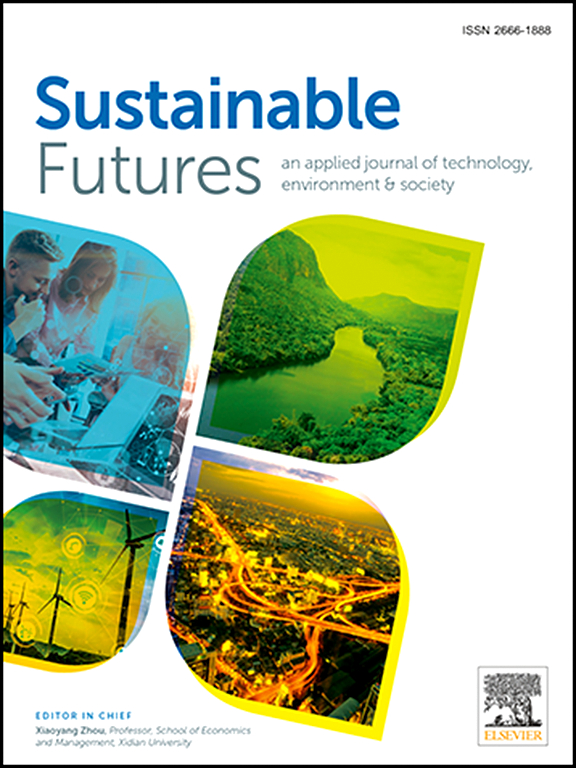Spatial coordination of electric vehicle adoption within the urban built environment using machine learning
IF 4.9
2区 社会学
Q2 ENVIRONMENTAL SCIENCES
引用次数: 0
Abstract
Adopting electric vehicles (EVs) aims to reduce urban carbon emissions from the demand side of transportation. However, there is limited understanding of how the urban built environment influences the process of EV adoption. As EV technology and the policy landscape continue to evolve, comprehending these dynamically developing relationships is crucial for promoting EVs and facilitating their coordination with existing urban infrastructure. This study proposes a data-driven machine learning framework to explore the nonlinear relationships and threshold effects between EV adoption and various urban environmental variables. By integrating GIS spatial analysis, we enhance the interpretability of the model results. Taking Beijing, China, as a case study, the findings confirm several factors previously identified as influencing EV adoption, such as charging infrastructure, population density, and economic development. Additionally, this study reveals regional insights that differ from existing research. Factors such as proximity to urban centers and the distance to, and accessibility of, public charging stations are no longer the most influential variables in the city. Compared to linear assumptions, a comprehensive analysis that includes multiple nonlinear variables enhances our understanding of the coordination of EVs within existing urban systems. The threshold effects from the results suggest a current 1.5-km radius for new charging infrastructure development around residential areas, while it is also important to consider other coordinating thresholds, such as the distance from the city center (10 km or 30 km), land-use mix entropy (around 0.7), and areas with low building coverage and low bus stop density. This study calls for more attention to the continuously evolving dynamic nonlinear relationship between EVs and various built environment variables.
使用机器学习的城市建筑环境中电动汽车采用的空间协调
采用电动汽车(ev)旨在减少城市交通需求侧的碳排放。然而,人们对城市建筑环境如何影响电动汽车采用过程的理解有限。随着电动汽车技术和政策环境的不断发展,理解这些动态发展的关系对于推广电动汽车并促进其与现有城市基础设施的协调至关重要。本研究提出了一个数据驱动的机器学习框架,以探索电动汽车采用率与各种城市环境变量之间的非线性关系和阈值效应。通过整合GIS空间分析,增强了模型结果的可解释性。以中国北京为例,研究结果证实了之前确定的影响电动汽车普及的几个因素,如充电基础设施、人口密度和经济发展。此外,这项研究揭示了不同于现有研究的区域见解。距离城市中心、公共充电站的距离和可达性等因素不再是城市中最具影响力的变量。与线性假设相比,包含多个非线性变量的综合分析增强了我们对现有城市系统中电动汽车协调的理解。研究结果表明,当前居民区周边新充电基础设施的发展半径为1.5 km,同时考虑其他协调阈值也很重要,如与市中心的距离(10 km或30 km)、土地利用混合熵(0.7左右)以及建筑覆盖率低和公交站点密度低的地区。该研究呼吁更多地关注电动汽车与各种建筑环境变量之间不断演变的动态非线性关系。
本文章由计算机程序翻译,如有差异,请以英文原文为准。
求助全文
约1分钟内获得全文
求助全文
来源期刊

Sustainable Futures
Social Sciences-Sociology and Political Science
CiteScore
9.30
自引率
1.80%
发文量
34
审稿时长
71 days
期刊介绍:
Sustainable Futures: is a journal focused on the intersection of sustainability, environment and technology from various disciplines in social sciences, and their larger implications for corporation, government, education institutions, regions and society both at present and in the future. It provides an advanced platform for studies related to sustainability and sustainable development in society, economics, environment, and culture. The scope of the journal is broad and encourages interdisciplinary research, as well as welcoming theoretical and practical research from all methodological approaches.
 求助内容:
求助内容: 应助结果提醒方式:
应助结果提醒方式:


